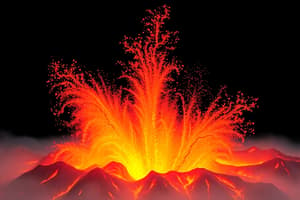Podcast
Questions and Answers
What type of volcano is characterized by its steep slopes and explosive eruptions caused by the interaction of magma with groundwater?
What type of volcano is characterized by its steep slopes and explosive eruptions caused by the interaction of magma with groundwater?
- Composite or stratovolcano (correct)
- Caldera volcano
- Stratocone volcano
- Shield volcano
Which of the following techniques is NOT commonly used by scientists to monitor volcanic activity?
Which of the following techniques is NOT commonly used by scientists to monitor volcanic activity?
- Gas emissions analysis
- Thermal imagery
- Seismology
- Satellite measurements of soil moisture (correct)
What is the primary cause of the formation of a caldera volcano?
What is the primary cause of the formation of a caldera volcano?
- Gradual buildup of volcanic ash and debris
- Fluid lava flows
- Interaction of magma with groundwater
- Collapse of the volcanic structure due to the removal of material during an eruption (correct)
Which of the following is a key strategy for mitigating the impacts of volcanic hazards?
Which of the following is a key strategy for mitigating the impacts of volcanic hazards?
What is one of the primary environmental impacts of volcanic eruptions?
What is one of the primary environmental impacts of volcanic eruptions?
What type of volcanic activity can indicate that a volcano is becoming more active?
What type of volcanic activity can indicate that a volcano is becoming more active?
What is a key role that satellite data plays in tracking volcanic activity?
What is a key role that satellite data plays in tracking volcanic activity?
What is a key component of assessing volcanic hazards?
What is a key component of assessing volcanic hazards?
What is a common mitigation strategy for volcanic hazards?
What is a common mitigation strategy for volcanic hazards?
What is one potential positive impact of volcanic activity on the environment?
What is one potential positive impact of volcanic activity on the environment?
Flashcards are hidden until you start studying
Study Notes
Volcanic Hazards
Understanding volcanic hazards is crucial for communities living near active volcanoes. These geological phenomena can pose significant threats to human life, infrastructure, and the environment. This article will discuss various aspects of volcanic hazards, including the different types of eruptions, methods for monitoring volcanic activity, assessing risks, implementing mitigation strategies, and their impact on the environment.
Types of Volcanic Eruptions
Volcanoes can exhibit a wide range of eruptive styles, from gentle effusion to explosive eruptions. The most common types include stratocone volcanoes, shield volcanoes, composite volcanoes, and caldera volcanoes. Stratocone volcanoes (also called shield volcanoes) typically have gentle slopes and form from fluid lava flows. Composite or stratovolcanoes are characterized by their steep slopes and explosive eruptions caused by the interaction of magma with groundwater. Caldera volcanoes are formed when a large part of the volcanic structure collapses due to the removal of material during an eruption.
Monitoring Volcanic Activity
Scientists monitor volcanic activity using various techniques such as seismology, gas emissions, thermal imagery, and satellite observations. These methods help detect early warning signs of possible eruptive events and provide valuable information for assessing potential hazards. For example, increased seismicity, changes in gas emissions, and ground deformation can indicate that a volcano is becoming more active. Satellite data also plays a crucial role in tracking volcanic activity, especially in remote areas where ground-based monitoring is difficult or impossible.
Hazard Assessment and Mitigation Strategies
Assessments of volcanic hazards involve understanding the types of eruptions, their likelihood, and potential impacts on human populations and infrastructure. This process helps prioritize risk reduction measures and inform emergency preparedness plans. Some common mitigation strategies include establishing evacuation routes, building protective structures, and educating communities about the risks associated with living near volcanoes. Additionally, scientists can make predictions about future eruptions based on historical patterns and ongoing monitoring data, which allows for better preparation and response planning.
Impact on Environment
Volcanic hazards can cause significant damage to the environment as well. Ashfall, pyroclastic debris, lahars (mudflows), and other volcanic materials can destroy habitats, contaminate water sources, and disrupt ecosystems. Long-term effects may include altered climate conditions due to volcanic gases and ash dispersed into the atmosphere. However, some volcanic activities can also have positive impacts on the environment, such as enriching soil nutrients and promoting plant growth after ash deposition.
In conclusion, understanding volcanic hazards is vital for ensuring the safety of communities living near active volcanoes. By monitoring volcanic activity, assessing potential hazards, and implementing appropriate mitigation strategies, scientists and emergency responders can help minimize the impact of volcanic eruptions on human life and the environment.
Studying That Suits You
Use AI to generate personalized quizzes and flashcards to suit your learning preferences.




